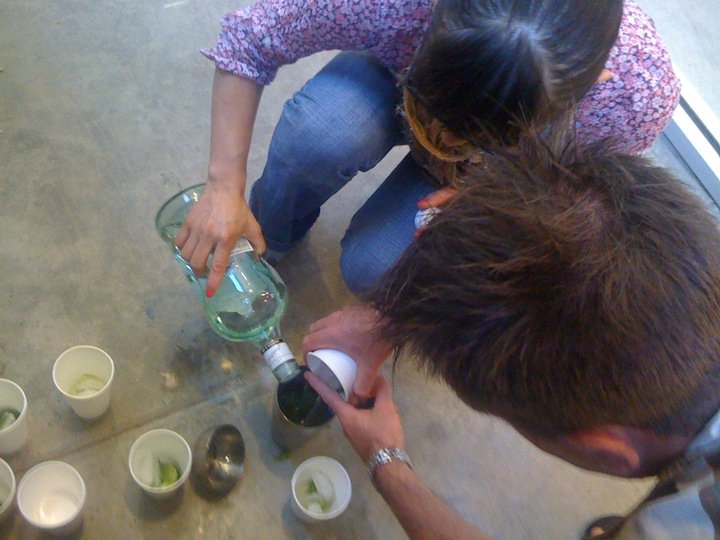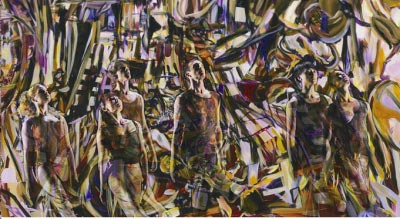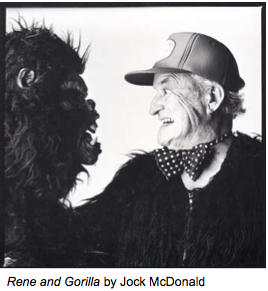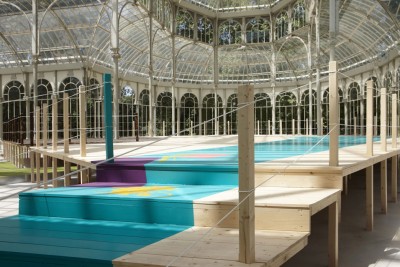Posts
Bay Area & Beyond
- View Bay Area posts >> | View Beyond posts >>
Bay Area
Stretcher re-launches at Arts Publishing Now at Southern Exposure
- Sunday, October 10th, 2010 | (0) Comments | Add comment >>
Land and Sea and Bad at Sports making mojitos on the floor during a long day of networking at the Art Publisher’s Fair. They’ve got a good attitude.


Friday night Internet prophet Ted Nelson presented his new self-published autobiography, Possiplex: Movies, Intellect, Creative Control, My Computer Life and the Fight for Civilization as the first public event in the grand sanctuary of the new Internet Archive space on Funston Avenue in San Francisco. The former church, an imposing pastiche of pillars, arches, and other architectural signifiers of the establishment, made a cultural about-face with the help of one hundred or so Nelson fans, including the legendary inventor Doug Englebart. Whether or not Nelson’s life-long quest to realize Xanadu, his vision for cyberspace, is implemented, he serves all Internet users by keeping an alternative vision of its possibilities alive. He’s clearly kept his spirits up with a sense of humor, and has written a book with a tang of the unique structures he discerns in digital information. Check it out at lulu.com

Thursday night, as a sold-out crowd settled in for a performance by the Margaret Jenkins Dance Company (MJDC) at the Jewish Community Center in San Francisco, a quick survey showed that the audience mixed dance aficionados, new music buffs, and art patrons. The draw for the art crowd was a video set by painter Naomie Kremer, who has been showing impressive paint/video hybrid works for the past five years. The second half of the program, Light Moves, was billed as a collaboration between MJDC, Kremer, composer Paul Dresher, and poet Michael Palmer and offered a chance to see what Kremer could do with stage space. Her work is more than a setting for the dancers; in the most successful passages lighting erases the barrier between the video and stage spaces so that dancers and projections become one. In the climactic scene, pictured here, painted-videoed-danced movements dart in and out of a particolored ground, offering the sensuous pleasure of a light show heightened with the dancers’ precise articulations of shifting emotions. This is a collaboration that makes sense. Unlike many interesting-sounding interdisciplinary collaborations that never get off the ground, Light Moves flies. Last night’s presentation was a preview of the work that will debut at the Yerba Buena Center for the Arts next year…watch for the next opportunity to see it.

Rene di Rosa, founder of Di Rosa, a public museum and sculpture park, died at home at the age 91 on the evening of October 3, 2010. His legacy of support for artists in Northern California is carried on through his extensive art collection and 217 acre estate in the Carneros region of the Napa Valley. A legendary philanthropist, art collector, and vineyardist, Rene di Rosa was born May 14, 1919 in Boston. He graduated from Yale University where he served as editor of the Yale Daily News. After serving in the US Navy, Rene moved to Paris where he hoped to write the “great American novel.” The book failed to materialize, but life on the Left Bank sparked his lifelong admiration for artists, and he purchased his first painting before returning to America and settling in San Francisco, where he took a job as general assignment reporter for the San Francisco Chronicle.
During the late 1950’s, Rene took a lively interest in the North Beach art community associated with “the Beats” in San Francisco, the beginning of five decades of acquiring what is now considered the most significant holding of Bay Area art in the world. During his life he served on the board of the San Francisco Museum of Modern Art, the National Advisory Board of the Whitney Museum of American Art, and was the recipient of many honors and awards for his patronage, including an Honorary Doctorate from the San Francisco Art Institute.
Friends and supporters are invited to bring messages and additions to an “ofrenda” altar installation by Diane Dame Shepp in the Di Rosa’s Gatehouse Gallery open during gallery hours (Wednesday through Friday 9:30 a.m. to 3 p.m.) through November 2.

At Madrid’s Cristal Palace located in the Retiro Park, Jessica Stockholder’s “Peer out to See” pleasantly occupies most of the structure in a balanced and engaging way. Riffing on the the location of the Palace next to a small pond, she has constructed a wooden platform (a “pier,” the first of many puns) that extends into the building. This is flanked on one side by a color-coordinated column of plastic household goods (unfortunately not the kind found at Pier One) and on the other by a star-shaped pool of green duckweed and a circle of orange pigment. On material terms, the piece easily shows Stockholder’s long and assured practice: everything contains a confidence of proportion, color, and weight. The piece occupies and alters the space without overwhelming it, and the space of the viewer’s movement within it seems both natural and well-considered. It takes advantage of both the light and lightness of the space to to provide an engaging experiece. As successful as it is, I did have the nagging sensation that the situation of walking the plank more could have had clearer (and possibly deeper) implications than what is found here. But perhaps that doubt is a measure of the work’s success. Maybe Stockholder is gently observing that we are always in danger of falling off the edge of the platform, the beauty of its surroundings is no barrier to the proximity of the dropoff.
As I left the building I came across several children tossing pieces of bread to several large fish, turtles, ducks, and a pair of black swans (indeed it appears that the entire ecosystem of the pond now depends on the kindness of small children). It was a reminder that in contrast to all the light and possibilities of lightness in “Peer Out to See,” the implications of two black swans hard by a crystal palace is something that no stockholder would wish to explore.
At the Caixa Photo Prize exhibition at the Caixa Forum in Madrid Emilio Morenatti’s winning entry is a set of portraits of Pakistani women who have deformed faces as the result of acid attacks. Though the images (and the stories that accompany them) are horrifying, their formal portraiture portrays the women with a dignity that their attackers would wish to deny. While most of the work on view from ten photographers depicts extreme poverty or situations of institutional violence, the photos share a moderate to high-gloss aesthetic - even Walter Astrada’s images of post-election violence in Kenya share the same color balance qualities of National Geographic. Only Mikel Aristregi’s photos of life among the alcoholic vagrants of Mongolia’s capital Ulan Bator occasionally present their subjects in a flatter light.
Staff at the exhibition said that the catalog sales for this annual exhibition are normally slow. But this year, with a stoic, acid-etched face staring out from its cover and many more contained within, the catalog has proved to be a surprise hit. While aestheticized images of violence make for a wider audience and more palatable viewing, I was left wondering what gripping but graphic photos didn’t make the cut because they weren’t photographic enough.
From the editors
Authors from Posts
- Allegra Fortunati
- Amar Chaudhary
- amy berk
- Asha Schechter
- Aude de Bourbon
- Berin Golonu
- Charles Linder
- Cheryl Meeker
- Dale Hoyt
- David Lawrence
- Diana Gaston
- Ed Osborn
- Elise Barclay
- Ella Delaney
- Glen Helfand
- Gloria Tanchelev
- Happy D
- Jeannine McDonald
- Julie Deamer
- Mark Van Proyen
- Megan Wilson
- Meredith Tromble
- Natalie Welch
- Terri Cohn
- Tucker Nichols
Archived Posts
- December, 2015
- October, 2015
- September, 2015
- July, 2013
- May, 2013
- April, 2013
- March, 2013
- August, 2012
- June, 2012
- March, 2012
- February, 2012
- January, 2012
- December, 2011
- October, 2011
- September, 2011
- July, 2011
- April, 2011
- March, 2011
- February, 2011
- January, 2011
- December, 2010
- November, 2010
- October, 2010
- September, 2010
- August, 2010
- July, 2010
- June, 2010
- April, 2010
- March, 2010
- February, 2010
- January, 2010
- December, 2009
- November, 2009
- October, 2009
- September, 2009
- August, 2009
- July, 2009
- June, 2009
- May, 2009
- April, 2009
- February, 2009
- January, 2009
- December, 2008
- November, 2008
- October, 2008
- September, 2008
- August, 2008
- July, 2008
- June, 2008
- May, 2008
- April, 2008
- March, 2008
- February, 2008
- December, 2007
- November, 2007
- October, 2007
- September, 2007
- August, 2007
- June, 2007
- May, 2007
- April, 2007
- March, 2007
- February, 2007
- January, 2007
- December, 2006
- November, 2006
- October, 2006
- September, 2006
- August, 2006
- July, 2006
- June, 2006
- May, 2006
- April, 2006
- March, 2006
- February, 2006
- January, 2006
- December, 2005
- November, 2005
- October, 2005
- September, 2005
- August, 2005
- July, 2005
- June, 2005
- May, 2005
- March, 2005
- February, 2005
- January, 2005
- December, 2004
- November, 2004
- October, 2004
- September, 2004
- August, 2004
- July, 2004
- June, 2004
- May, 2004
- April, 2004
- March, 2004
- February, 2004
- January, 2004
- December, 2003
- November, 2003
- October, 2003
- September, 2003
- August, 2003
- July, 2003
- June, 2003
- May, 2003
- April, 2003
- March, 2003
- February, 2003
- January, 2003
- December, 2002
- November, 2002
- October, 2002
- September, 2002
- August, 2002
- July, 2002
- June, 2002
- May, 2002
- April, 2002
- March, 2002
- February, 2002
- January, 2002
- December, 2001
- November, 2001
- October, 2001
